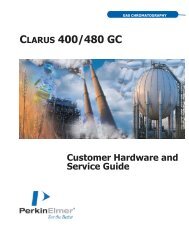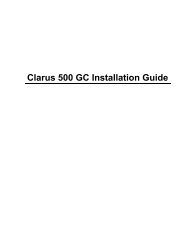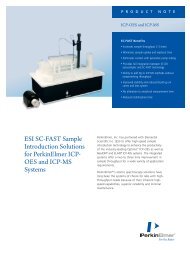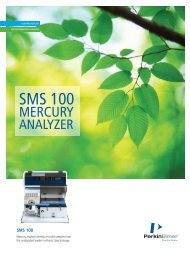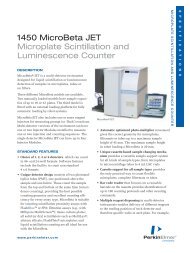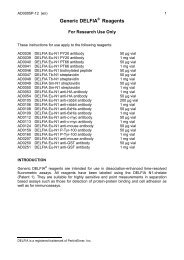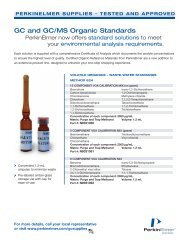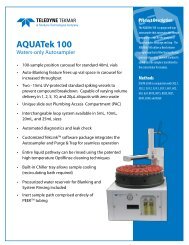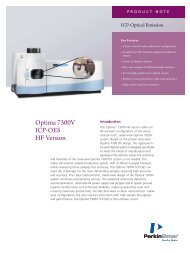HT Protein Charge Variant Kit User Guide - PerkinElmer
HT Protein Charge Variant Kit User Guide - PerkinElmer
HT Protein Charge Variant Kit User Guide - PerkinElmer
You also want an ePaper? Increase the reach of your titles
YUMPU automatically turns print PDFs into web optimized ePapers that Google loves.
<strong>HT</strong> <strong>Protein</strong> <strong>Charge</strong> <strong>Variant</strong> <strong>Kit</strong> <strong>User</strong> <strong>Guide</strong><br />
Frequently Asked Questions<br />
<strong>Kit</strong> Components<br />
1. Is there a lower marker for this assay?<br />
No. The assay has been optimized to minimize variation in migration time (see Troubleshooting section<br />
for more details). Alignment to a lower marker should not be necessary.<br />
2. Is there a charge or pI ladder for this assay?<br />
No. Similar to conventional CZE assays, this assay does not provide pI information.<br />
Sample Preparation<br />
1. May other desalting methods be used, besides Zeba Desalting plates and columns?<br />
Yes, however Zeba Desalting plates and columns were used in the validation of the assay and are<br />
therefore preferred.<br />
2. What happens to the dye when it is not used immediately after dilution with DMF?<br />
When left at room temperature for extended periods of time (hours), the dye mixture will degrade,<br />
causing inefficient labeling and resulting in low sample signal.<br />
3. Can labeled samples be used on another day?<br />
We recommend that samples are analyzed immediately after labeling. However, labeled samples may<br />
be frozen and analyzed later. A loss in signal may result from this storage.<br />
4. Can labeled samples be reconstituted in less or more than 60 µL of molecular-grade water?<br />
The 60 µL dilution gives the optimal signal and profile reproducibility. Other dilutions may be used;<br />
however, signal and reproducibility may be compromised.<br />
5. Can the samples be labeled for more than 10 minutes, or less than 10 minutes?<br />
The recommended 10 minutes is the shortest labeling time that will give the specified reproducibility.<br />
Shorter labeling times will compromise reproducibility; longer labeling times are not likely to affect<br />
reproducibility.<br />
6. What is the lowest sample concentration that I can use?<br />
The recommended range is 0.5 - 10 mg/mL. The reproducibility of % Relative Amount measurements<br />
may decrease for concentrations < 0.5 mg/mL, but detection below this limit is possible.<br />
7. Can I label less than 24 samples?<br />
Yes. To label less than 24 samples, reduce the volume of Dye Concentrate and N,Ndimethylformamide<br />
proportionately. For example, to label 12 samples, add 2.5 µL Dye Concentrate to<br />
72.5 µL N,N-dimethylformamide.<br />
8. Can I analyze a sample with a pI outside of the specified range?<br />
Probably not. Lower pI mAbs may migrate too slowly and not elute before the end of the separation<br />
time, even for the 110s assay. Higher pI mAbs may not be sufficiently resolved, even at pH 7.2.<br />
9. Can proteins other than monoclonal antibodies be tested using this assay?<br />
The <strong>HT</strong> <strong>Protein</strong> <strong>Charge</strong> <strong>Variant</strong> assay was developed using only monoclonal antibodies. However, it<br />
may be possible to resolve the variants of other proteins with pI in the range of 7 - 9.5.<br />
_________________________________________________________________________________________<br />
Caliper - a <strong>PerkinElmer</strong> Company Page 15 of 18 PN: CLS135474 Rev. 02<br />
68 Elm Street<br />
Hopkinton, MA 01748-1668<br />
1-877-LABCHIP (1-877-522-2447)



